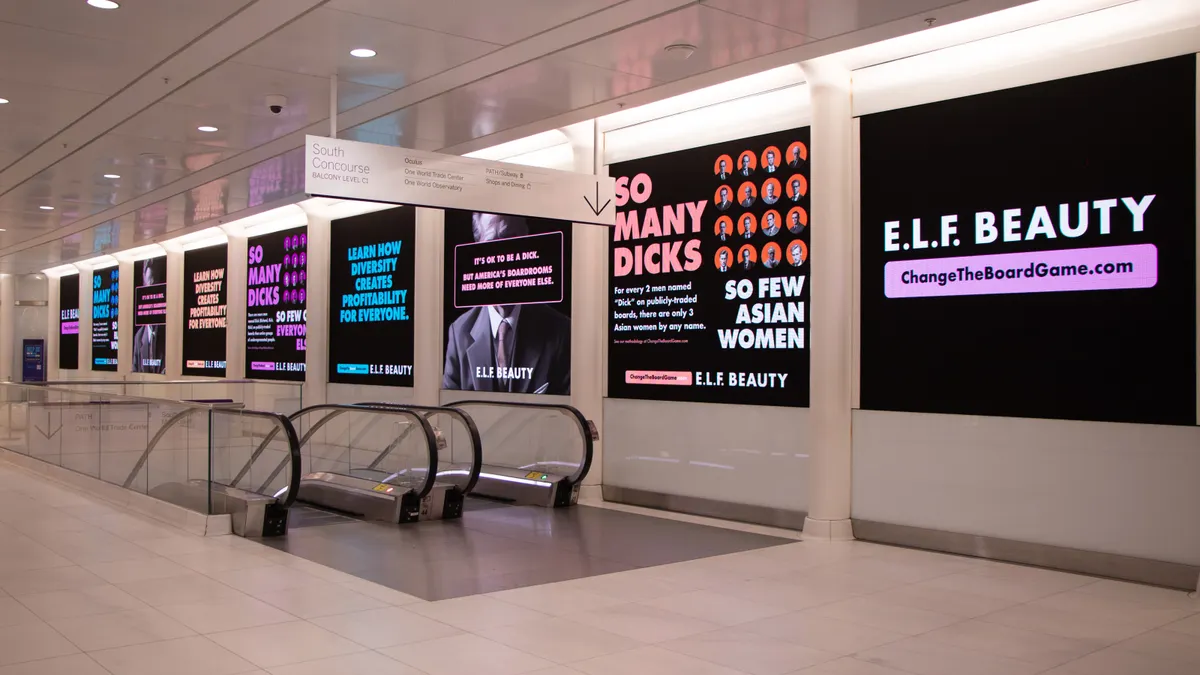Verizon Communications dipped its virtual toes back into the metaverse with a multicity augmented reality (AR) activation last month as Apple rolled out its latest smartphone models. The mobile carrier sought to showcase the faster speeds of its 5G network with a multimedia experience that offered a chance to win an iPhone 13 and leveraged spatial audio and gamified social media.
The centerpiece of the campaign was a treasure hunt called H1DD3N that launched on Sept. 18 in geofenced parts of Chicago, Los Angeles, Miami, New York and Seattle. Verizon set up signs printed with QR codes that asked people to scan them with a smartphone camera to see digital imagery overlaid on their surroundings. A virtual reality (VR) experience enabled those at home to be a part of the action. Once placed, characters could be seen by those participating from the geofenced areas and could interact with the real-world locations.
"AR allows us to meet our consumers in a new metaverse, reimagining our worlds and how we engage on a deeper level," Andrew McKechnie, chief creative officer at Verizon, said by email.
Parallel worlds
Verizon's AR experience included a recently released music track from pop singer Halsey and digital imagery from the FriendsWithYou art collaborative. Participants who found a hidden number 13 and shared it on Twitter were given a chance to win a new iPhone. To extend the campaign's reach, Verizon offered people not at the geofenced locations a way to participate by creating unique FriendsWithYou character art and posting it to Twitter with the hashtag #Hidden13.
The telecommunications company worked with agency R/GA, which used WebAR technology from developer platform 8th Wall, to create the metaverse environment for people to explore. The deployment included Verizon's 5G Ultra Wideband network to support the placement of digital artwork at a specific location. World tracking tech let smartphone users move throughout the parallel AR world and see digital objects from different angles.
AR usage has grown steadily after games like Pokemon Go and social apps including Snapchat have popularized the idea of enhancing real-world activities with computer-generated interactions. The number of AR users in the U.S. will grow 11% to 93.3 million this year and reach 110.1 million by 2023, eMarketer estimates.
A convergence of 5G, artificial intelligence (AI) and decentralized cloud computing is making it easier to deliver more seamless extended reality experiences on connected devices, the researcher noted. So-called metaverse experiences have drawn attention of a growing number of marketers this year, including Facebook, Coca-Cola and Hyundai.
5G expansion
The campaign comes as 5G adoption continues to swell. About 20% of Verizon's consumer wireless customers have adopted the higher-speed technology as they use smartphones equipped with a 5G chip, according to the company's quarterly earnings report. The higher-speed phones helped to drive greater demand for data, with 60% of new customers signing up for unlimited premium plans. Verizon said it added 528,000 retail postpaid connections, including 275,000 phone subscribers, to end the June quarter with 121.3 million total retail connections.
Meanwhile, Verizon this year expanded its investment in 5G by committing $45.5 billion to license airwaves for the higher-speed wireless service. It secured more than half of the midrange spectrum rights in a U.S. government auction with a bid that was higher than AT&T's and T-Mobile's offers, CNBC reported.
Apple has added to the impetus for wireless companies such as Verizon, T-Mobile and AT&T to invest in their 5G networks by adding the technology to the iPhone, which is the most popular smartphone in the U.S. Apple's share of smartphone sales was 53% during Q2, according to Counterpoint Research.
Building on 5G experiences
Verizon's AR and audiovisual experience builds on its past efforts to showcase 5G technology with immersive, geolocated content. As a sponsor of the Super Bowl, the company developed a 5G SuperStadium earlier this year in the NFL mobile app that let iPhone users watch the game from different camera angles. The campaign was notable for giving people a chance to see 5G service in action, unlike its effort a year earlier that was focused on how 5G technology was expected to change the lives of emergency personnel, football fans and consumers.
Verizon also has made AR tech a key part of campaigns to promote its 5G service. Last year, Verizon introduced its first AR activation for 5G customers on Snapchat with a virtual musical performance by Black Pumas singer Eric Burton in New York City. Verizon customers who opened the photo-sharing app and used the Verizon Lens saw a 3D Bitmoji version of Burton dance amid digital animations. Demonstrating 5G's power to deliver data-intensive content like AR experiences is an important strategy in urging consumers to upgrade their smartphones and data plans.
"People are consuming more content than ever and looking for second-screen experiences that are immersive and engaging," McKechnie said.





















